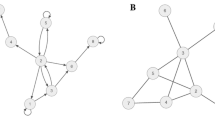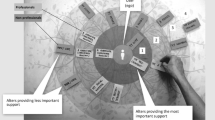Abstract
Despite a recent renewal of interest in natural community support networks and self-help groups, there currently exist no systematic therapeutic approaches for working with network systems. Over the past two decades advances in the field of social network analysis have laid the groundwork for its conversion to a clinical tool. This paper illustrates how network analysis can provide quantitative and qualitative data useful in therapeutic interventions and agency planning decisions.
Similar content being viewed by others
References
Auerswald, E. H. Interdisciplinary versus ecological approach.Family Process, 1968,7, 202–215.
Barnes, J. Class and committees in Norwegian island parish.Human Relations, 1954,7, 39–58.
Berkman, L. Social isolation shortens lives.Medical World News, January 8, 1978, p. 13.
Bott, E.Family and social networks. London: Tavestock, 1957.
Bourg, C. The elderly in a southern metropolitan area.Gerontologist, 1975,15, 15–22.
Brown, G. W., Birley, J. L. T., & Wing, J. K. Influence of family life on the course of schizophrenic disorders: A replication.British Journal of Psychiatry, 1972,121, 241–258.
Budson, R.The crucial factor in community program success. Paper presented at 130th annual meeting of the American Psychiatric Association, Toronto, Canada, May 1977.
Cantor, M. Life space and the social support system of the inner city elderly of New York.Gerontologist, 1975,15, 23–27.
Caplan, G.Support systems and community mental health. New York: Behavioral Publications, 1974.
Cassel, J. The relation of the urban environment to health: Implications for prevention.Mt. Sinai Journal of Medicine, 1973,40, 539–550.
Clark, M. Patterns of aging among the elderly poor in the inner city.Gerontologist, 1971,11 (Part II), 58–66.
Clark, M., & Anderson, B. G.Culture and aging: An anthropological study of older Americans. Springfield, Ill.: Charles C. Thomas, 1967.
Cohen, C. Nocturnal neurosis of the elderly: Failure of agencies to cope with the problem.Journal of the American Geriatrics Society, 1976,24, 86–88.
Cohen, C., & Sokolovsky, J. Schizophrenia and social networks.Schizophrenia Bulletin 1978,4, 546–560.
Collins, A., & Pancoast, D. L.Natural helping networks. Washington, D.C.: National Association of Social Workers, 1976.
Dumont, M. P. Tavern culture, the sustenance of homeless men.American Journal of Orthopsychiatry, 1967,37, 938–945.
Eckert, J. K.Health status, adjustments, and social supports of older people living in center city hotels. Paper presented at the annual meeting of the Gerontological Society, San Frnacisco, California, November 1977.
Ehrlich, P.Study of the St. Louis invisible elderly: Needs and characteristics of aged “single room occupancy” downtown hotel residents. (Mimeograph), 1976.
Freeman, H., & Simmons, O.The mental patient comes home. New York: Wiley, 1963.
Gruenberg, E. Community conditions and psychosis of the elderly.American Journal of Psychiatry, 1954,110, 888–896.
Hammer, M. Influence of small social networks as factors in mental hospital admission.Human Organization, 1963–64,22, 243–251.
Hammer, M., Barrow, S., & Gutwirth, L.A micro-social study of schizophrenic ex-patients in a community setting. Draft of proposal (mimeograph), 1976.
Hammer, M., & Schaffer, A. Interconnectedness and the duration of connections in several small networks.American Ethologist, 1975,2, 297–308.
Hoffman, L., & Long, L. A systems dilemma.Family Process, 1969,8, 211–234.
Jackson, D. D. The individual and the larger contexts.Family Process, 1967,6, 139–147.
Jay, E. The concepts of “field” and “network” in anthropological research.Man, 1964,64, 127–139.
Kaplan, B. H., Cassel, J. C. & Gore, S. Social support and health.Medical Care, 1977,15, (supplement), 47–58.
Kowal, C.SRO housing: A national need. Mimeographed copy of report of the Housing and Development Administration of the City of New York, 1973.
Lopata, H. Support systems of elderly: Chicago of the 1970s.Gerontologist, 1975,15, 35–41.
Lowenthal, M. F. Social isolation and mental illness in old age.American Sociological Review, 1964,29, 54–70.
Mannino, F. V., & Shore, M.F. Ecologically oriented family intervention.Family Process, 1972,11, 499–504.
Mitchell, J. C. Concept and use of social networks. In J. C. Mitchell (Ed.),Social networks in urban situations. Manchester, England: Manchester University Press, 1969.
Murray Hill SRO Project, 1976, personal communication.
Pattison, E. M. Social system psychotherapy.American Journal of Psychotherapy, 1973,27, 396–409.
Rabkin, J. G. & Struening, E. L. Life events, stress, and illness.Science, 1976,194, 1013–1020.
Riessman, F.The role of self-help groups in the mental health field. Paper presented at the annual meeting of the American Psychiatric Association, Atlanta, Georgia, May 1978.
Shapiro, J.Communities of the alone. New York: Association Press, 1971.
Sokolovsky, J., & Cohen, C.The myth of isolation: Personal networks of inner-city elderly. Paper presented at the annual meeting of the Society for Applied Anthropology, April 1977.
Sokolovsky, J., Cohen, C., Berger, D., & Geiger, J. Personal networks of ex-mental patients in a Manhattan SRO hotel.Human Organization, 1978,37, 5–15.
Speck, R., & Attneave, C.Family networks. New York: Pantheon, 1973.
Stephens, B. J.Loners, losers, lovers: Elderly tenants in a slum hotel. Seattle, Wash.: University of Washington Press, 1976.
Williams, W. S., & Jaco, E. G. An evaluation of functional psychoses in old age.American Journal of Psychiatry, 1958,114, 910–916.
Author information
Authors and Affiliations
Additional information
The authors wish to thank Joan Mintz, Henry Rajkowski, Alan Laskow, Lynne Stein, John Stern, Mindy Horrow, Alissa Fox, Simeon Feinberg, the Bellevue Geriatrics Unit, and the Murray HIll SRO Project for Their assistance. This research was partially supported by grants from the Ittleson Foundation, the New York Foundation, and the vanAmeringen Foundation.
Rights and permissions
About this article
Cite this article
Cohen, C.I., Sokolovsky, J. Clinical use of network analysis for psychiatric and aged populations. Community Ment Health J 15, 203–213 (1979). https://doi.org/10.1007/BF00766008
Issue Date:
DOI: https://doi.org/10.1007/BF00766008




